Are you stuck on page two of the search results, or worse? Do you want to be on Google’s first page of results? SEO enthusiasts, fear not! This comprehensive guide to on page SEO tactics is your one-stop solution for dramatically improving your website’s ranking. With plenty of real-world examples, this article will break down the newest tactics and trends to make optimization simple.
Get ready to dominate the search results, unleash a flood of organic traffic, and surpass your competition. Let’s dive in and unleash the full On page SEO potential of your website!
Demystifying On Page SEO for Ultimate Website Success!
Ever wondered why some websites rank at the top of search results while others don’t? On page SEO is the key to this puzzle. But what exactly is it, and why does it matter to you?
On page SEO refers to the optimization strategies used on your website to improve its search engine ranking. Think of search engines as investigators that analyze webpages to assess their relevance and content. By ensuring that your website’s content, structure, and technical aspects are optimized, you essentially help these investigators understand the purpose of your website. The better they comprehend your site, the more likely they are to rank it for relevant search terms.
Think of it this way: a well-organized and well-maintained store is much easier to navigate and shop in compared to a disorganized one. Similarly, websites that offer a similar user experience are rewarded by search engines with higher search result rankings.
5 Steps to Unlock the Potential of Keyword Research
Are you ready to supercharge your website with the perfect keywords? Let’s dive into the exciting world of keyword research for On Page SEO and find out how you can do it all by yourself.
Step 1: Kickstart Your Brainstorming Session
Think of keywords as the foundation of your website’s content. Start by identifying a “seed keyword” that represents your niche. For instance, if you own an online guitar store, your seed keyword could be “guitar”.
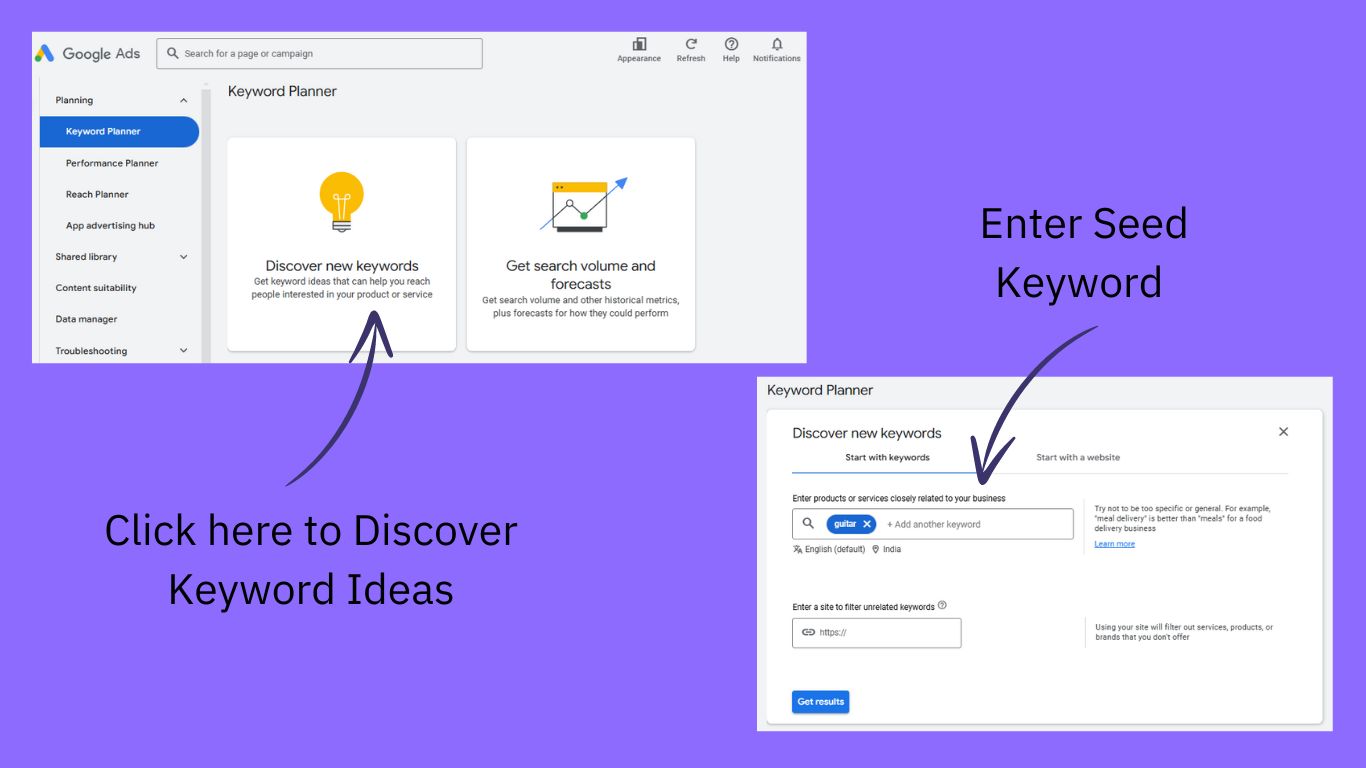
Step 2: Harness the Power of Free Keyword Tools
On Page SEO journey starts with Keyword Research, and for it you must start with the free tools. Get ready to uncover a goldmine of free keyword research tools!
Here are some top picks to get you started:
- Google Keyword Planner: This amazing tool from Google lets you explore related keywords and estimate their search volume. Aim for keywords with a search volume above 1000 for your initial targeting.
- Keywordtool.io, Ubersuggest, Ahrefs Keyword Generator: These fantastic free tools provide a plethora of keyword suggestions beyond search volume. Explore them to discover even more relevant terms.
- Answer the Public: This clever tool uncovers the questions people are asking about your seed keyword. These long-tail phrases are pure gold for attracting targeted traffic.

Step 3: Discover the Power of Keywords with Google Trends
While Not all keywords are created equal! Google Trends offers a fascinating insight into keyword longevity by showcasing search volume trends over the past year. Seek out keywords with a stable or upward trend to guarantee consistent organic traffic in the future. Rate the trend on a scale of 0-10 (0 being a downward trend, and 10 representing a fantastic upward trend). For on page SEO, longevity of keyword is essential for consistent organic traffic.
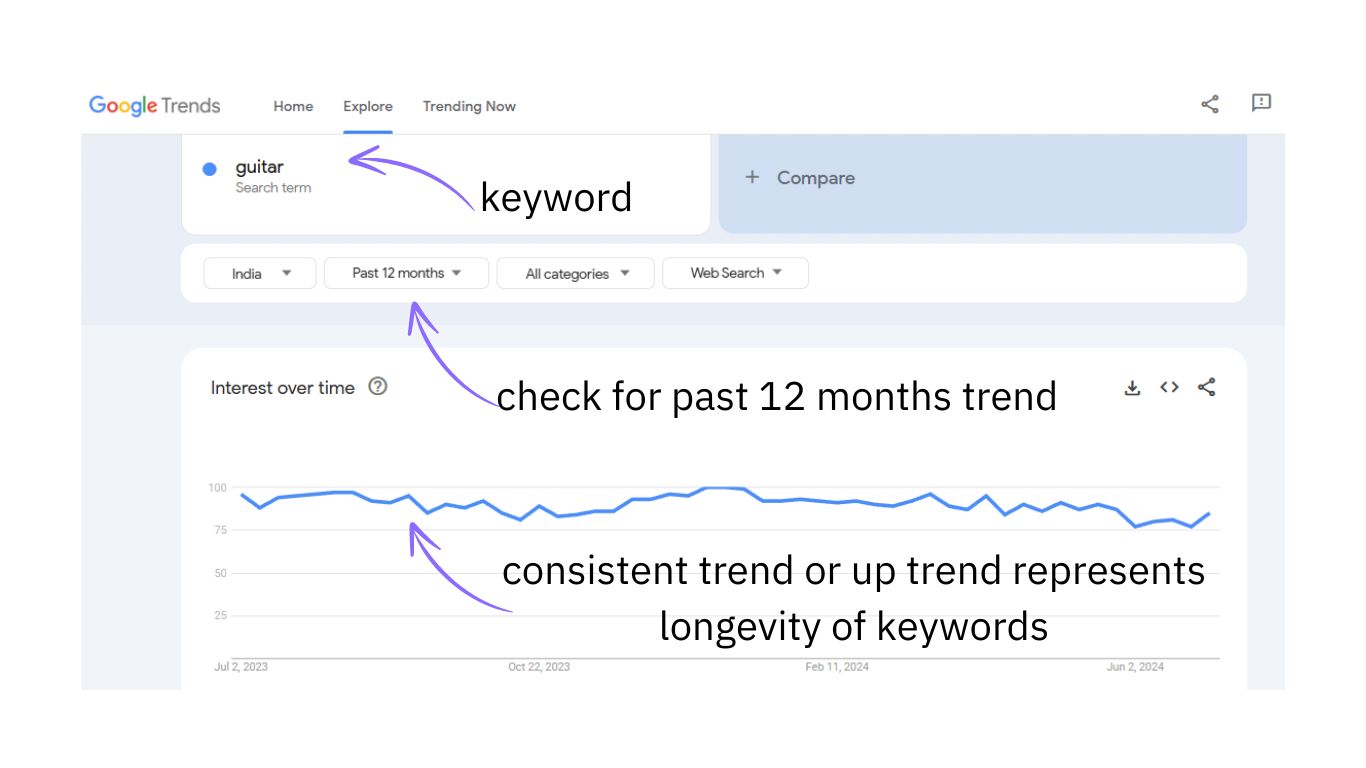
Step 4: Analyse Keyword Difficulty with MOZ Bar Chrome Extension
Picture ranking for a keyword as conquering a mountain. Some keywords are like scaling Mount Everest, while others are as gentle as hills. The MOZ Bar Chrome Extension assists in estimating a website’s Domain Authority (DA) and Page Authority (PA) – crucial metrics that indicate the difficulty of ranking for a keyword. Websites with a DA/PA of less than 25 in the top 10 search results suggest a lower difficulty keyword. Rate the difficulty on a scale of 0-10 (0 being extremely high DA/PA – hard to rank, while 10 being extremely low DA/PA – easy to rank).
with difficult keywords, you will find that only
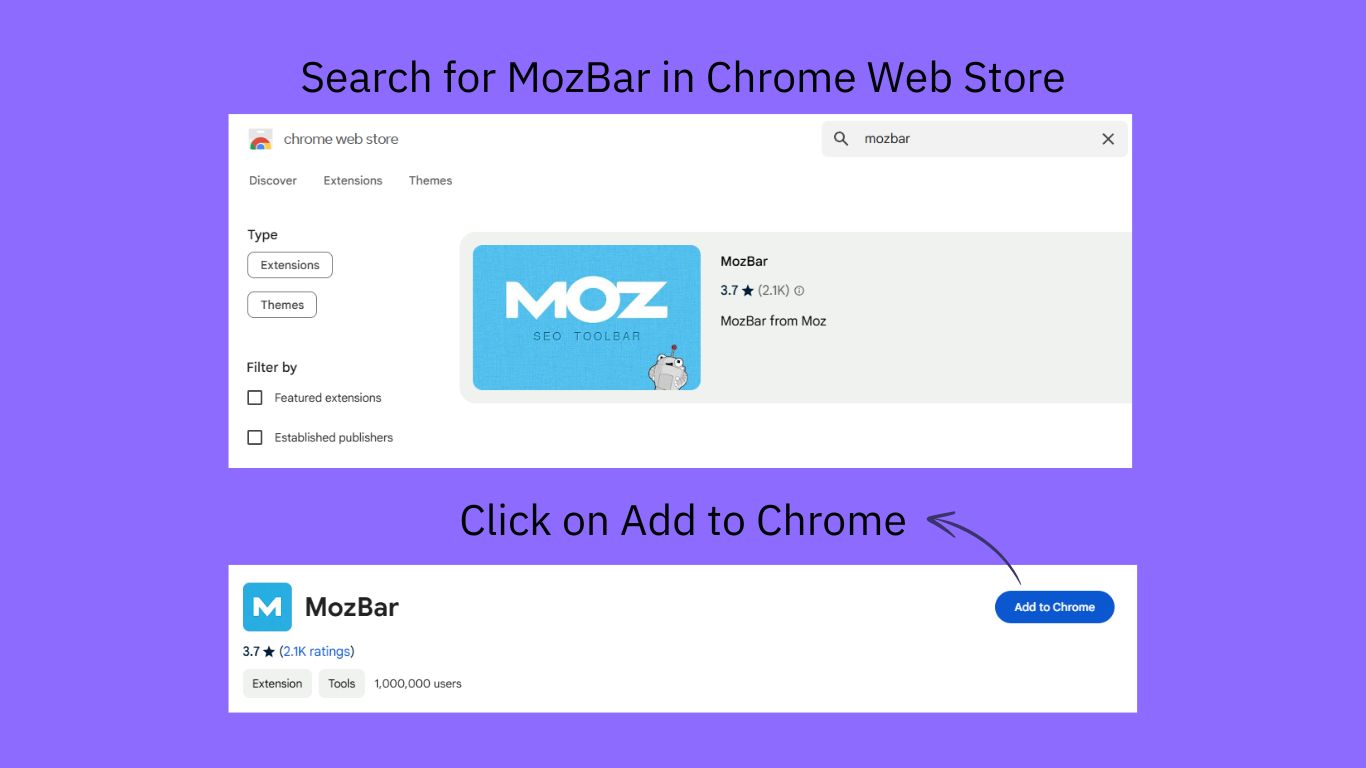
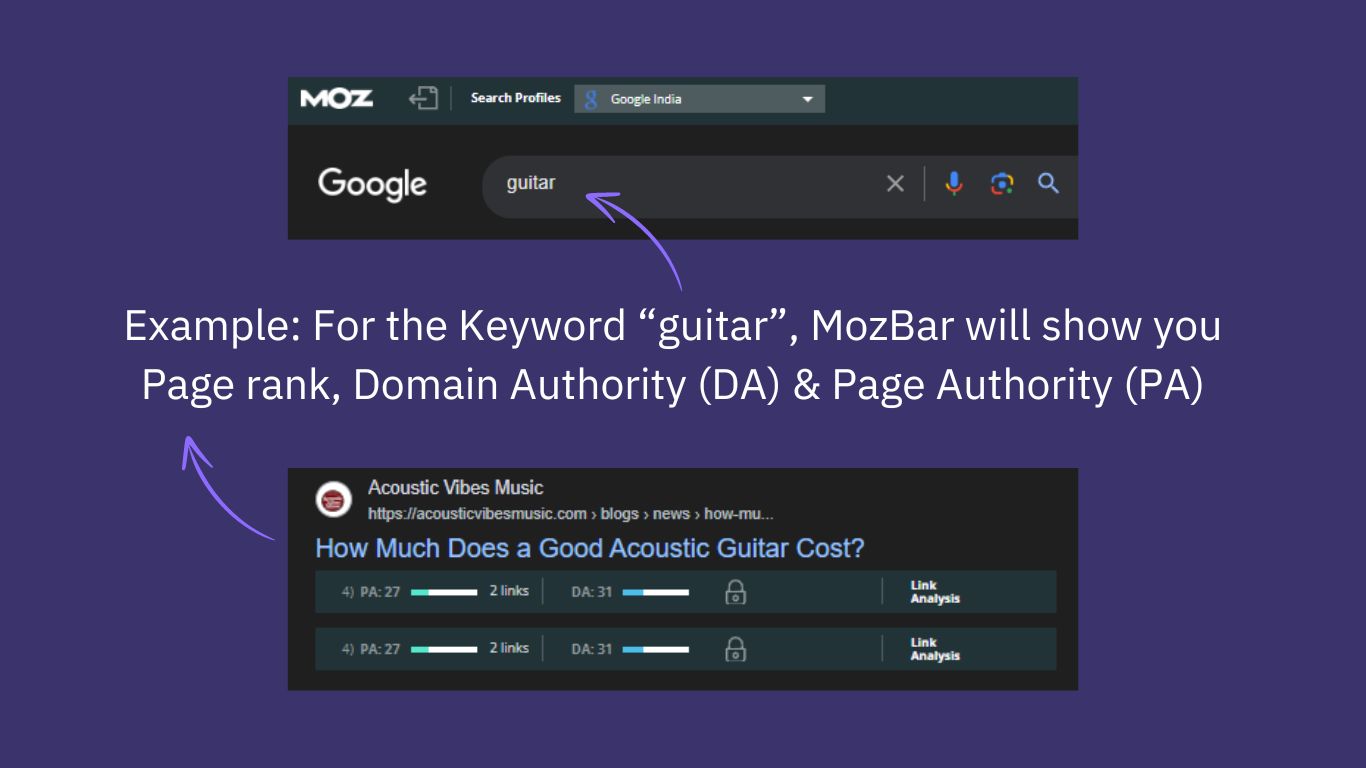
Step 5: Embrace Your Champions
Now comes the exciting part – selecting your target keywords!
Prioritize keywords with: High Search Volume: Target keywords with a minimum of 1000 monthly searches. Positive Trend (Google Trends): Opt for keywords with a stable or increasing search volume trend. Low Difficulty (Moz Bar): Focus on keywords where the top 10 ranking websites have a lower DA/PA.
PRO Tip: Don’t just rely on search volume alone! Consider the intent behind the keyword. For example, are people looking for information (e.g., “how to play guitar”) or ready to buy (e.g., “best acoustic guitar for beginners under 5000”)? Choose keywords that align with your website’s goals.
Crafting Content That Captivates Both Users and Search Engines
When it comes to on-page SEO, content truly reigns supreme! It’s not just about throwing together words; it’s about creating top-notch content that resonates with both search engines and your target audience. Let’s dive into how to strike the perfect balance:
Captivating Content for both Readers and Search Engines
Informative and Engaging: Focus on crafting valuable, informative content that genuinely assists your audience. Answer their questions, solve their problems, and offer fresh insights. Not only does this keep readers engaged, but it also establishes your website as a trusted resource. Search engines favor websites with content that demonstrably satisfies user intent.
Structured for Success: Readability is crucial. Use clear headings, subheadings, and bullet points to break down your content into easily digestible chunks. This enhances user experience and helps search engines understand your content’s hierarchy and key points.
Keyword Harmony: Targeted keywords are essential for search engine visibility, but avoid falling into the trap of keyword stuffing. Integrate your keywords naturally throughout your content to ensure they flow seamlessly and enhance readability.
Quality SEO Content Matters
When aiming to boost our website’s visibility, user engagement is key. According to recent insights from Google APIs, user interaction and session time play crucial roles in determining our page’s ranking on search engine results. To ensure a top spot on the SERPs, we must focus on creating high-quality, engaging content.
To achieve this, we need to curate in-depth blog posts spanning 1500-2000 words. Breaking down the content with strategic headings and subheadings is essential for enhancing readability. Each heading should incorporate the focus keyword and align with the overall structure and title of the blog. Additionally, the content should include a compelling 100-word introduction that sets the stage and a concise conclusion providing key takeaways.
By implementing these tactics, we can deliver top-notch content that captivates our audience and elevates our ranking on search engine results.
Staying Ahead of the Curve: Recent Trends
The world of SEO is always evolving, and it’s important to keep these key trends in mind:
EAT (Expertise, Authoritativeness, and Trustworthiness): Establish yourself as an expert by showcasing your qualifications, experience, and positive user reviews to significantly boost your content’s authority and ranking potential.
Content Freshness: Regularly update your content with fresh, relevant information to demonstrate your commitment to providing the latest and greatest information, as search engines favor websites that consistently update their content.
Keep up the great work! Your enthusiasm and professionalism will surely shine through in your SEO efforts.
SERP Snippet for High Click-Through Rates
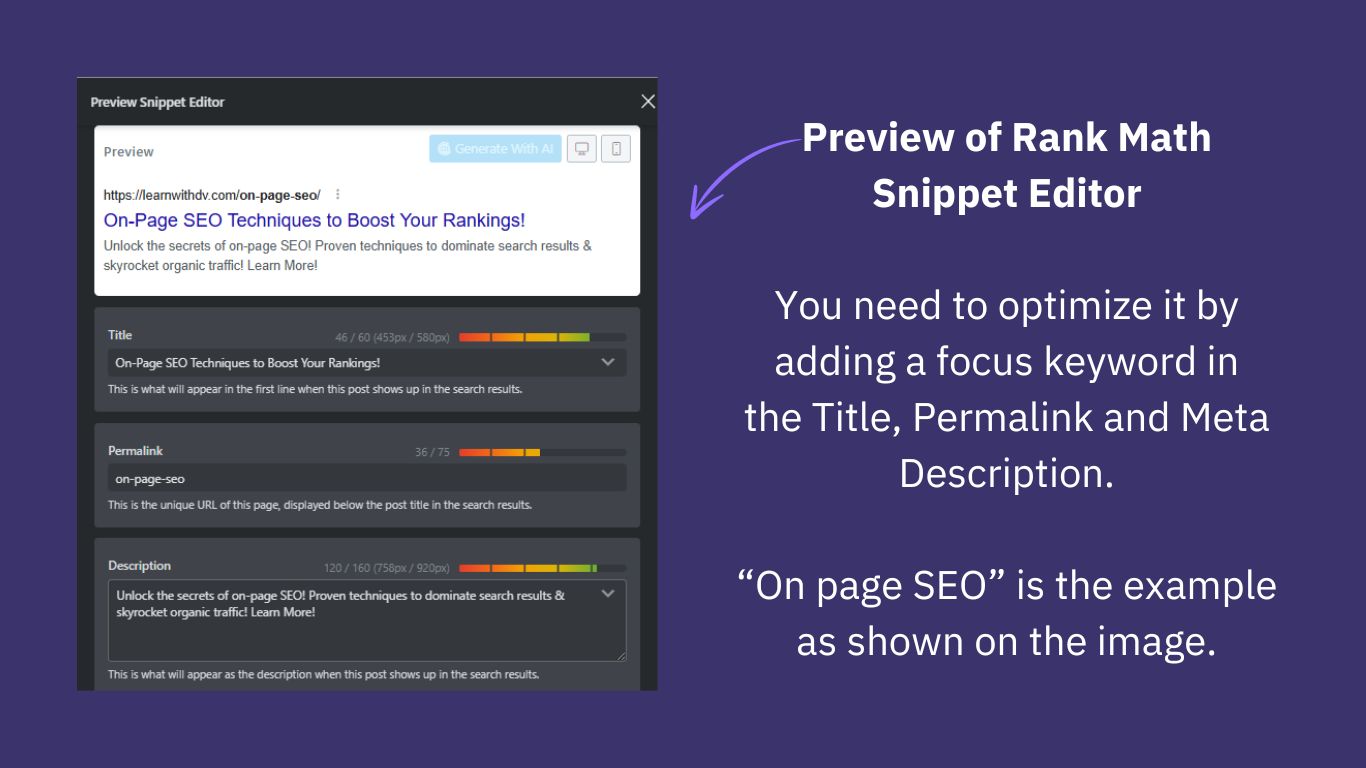
Picture your website’s content as a beautifully organized store. Just as clear signage in a physical store guides customers to their desired products, titles, headings, and meta descriptions do the same for users and search engines, ensuring they find exactly what they’re looking for.
1. Title (Under 60 characters): Let’s craft a title that commands attention and boosts your site’s visibility! Keep the primary keyword “On-page SEO Techniques” front and center, highlight the benefit with “Boost Your Rankings!”, and aim for under 60 characters.
Example Title: On-Page SEO Techniques to Boost Your Rankings!
2. URL (Clear and Descriptive): Your URL should be a window to what’s inside. Incorporate the main keyword “on-page-seo,” keep it brief and relevant, and ensure it accurately represents your content. Example URL: [invalid URL removed]
3. Meta Description (Under 160 characters): Time to captivate your audience with a compelling meta description! Start with a bold hook like “Unlock the secrets of on-page SEO!”, briefly explain the value proposition, and include a call to action (CTA) such as “Learn More!”
Example of Meta Description: Unlock the secrets of on-page SEO! Proven techniques to dominate search results & skyrocket organic traffic! Learn More!
Remember, clarity and keyword relevance are the keys to unlocking your site’s potential. Crafting clear titles, headings, and meta descriptions not only enhances user experience but also communicates to search engines the value and structure of your content, leading to higher click-through rates (CTR) and improved search engine ranking.
Technical On Page SEO: Elevating Performance
Ensuring technical SEO for your website is essential for seamless search engine crawling and indexing. Just imagine a stunning store in a remote location with no roads leading to it – that’s what a technically flawed website is like for search engines. Technical SEO guarantees that your website is accessible, crawlable, and user-friendly, enabling search engines to effortlessly find, understand, and index your content.
When it comes to optimizing for speed and mobile, page speed is paramount in today’s fast-paced world. Users expect lightning-fast loading times, so optimizing images, compressing code, and leveraging caching mechanisms is crucial. Additionally, with mobile usage surpassing desktop, having a mobile-friendly website is no longer optional. Responsive design is key to ensuring your website seamlessly adapts to any device, providing an optimal user experience for all visitors.
Implementing strategies such as image optimization, responsive design, and internal linking are essential for building a strong website structure. Internal linking creates a well-organized network of pathways within your website, enhancing user experience and helping search engines understand the hierarchy and flow of your content.
Recent advancements like schema markup add rich labels to your website’s content, providing search engines with additional context about your content. This can lead to richer search results and significantly improve click-through rates.
By prioritizing technical on page SEO, you lay the groundwork for a website that search engines can easily access and understand. Coupled with strong content and user experience, this creates a winning formula for long-term SEO success.
Advanced On Page SEO Techniques
Once you’ve nailed down the fundamental principles of on-page SEO, get ready to explore the exciting world of advanced strategies to elevate your website’s optimization to the next level.
Supercharge Your Website with Image Optimization
Images are not just visually appealing; they hold remarkable potential for SEO. Craft descriptive alt text for each image to provide essential information to search engines and visually impaired users. Instead of generic labels like “picture1.jpg,” opt for detailed descriptions like “Woman hiking on a scenic mountain trail.”
Unleash the Power of Backlink Authority
Imagine backlinks as endorsements for your website. When reputable websites link to your content, it establishes trust and relevance with search engines. Generating backlinks requires effort, but it’s worth it. Here are some tactics to consider:
- Create Compelling Content: Develop informative and engaging content that naturally attracts links from other websites.
- Guest Blogging: Contribute guest posts to niche-relevant websites, including a link back to your site within the content. Quality over quantity is the golden rule for backlinks. Focus on earning links from reputable websites in your niche
Track and Improve Your On-Page SEO Performance
On page SEO is an ongoing journey. To ensure continuous progress, utilize website analytics tools to track your performance. Leverage tools like Google Search Console to monitor metrics such as organic traffic, keyword rankings, and user engagement. Use the data to make informed decisions to enhance your SEO strategy.
By analyzing the data, you can pinpoint areas for improvement and take decisive action to enhance your website’s performance.
On Page SEO can reach new heights by monitoring keyword rankings in Google Search Console and optimizing user engagement based on insights from Google Analytics. It’s all about fine-tuning and enhancing your website’s performance for ultimate success.